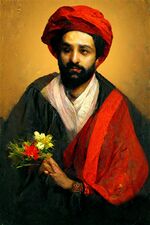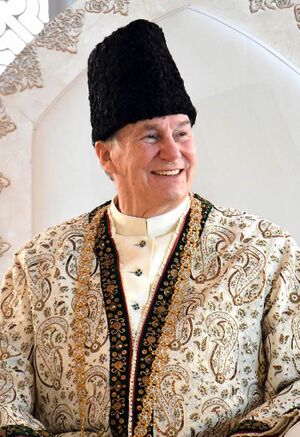Auxiliary Imam: Difference between revisions
No edit summary |
No edit summary |
||
| Line 24: | Line 24: | ||
}} | }} | ||
{{Esoteric Shi'ism Sidebar}} | {{Esoteric Shi'ism Sidebar}} | ||
RETCONNED | |||
The '''Auxiliary Imam''' ({{wp|Indonesian language|Indonesian}}: ''Imam Auxilier''; {{wp|Dutch language|Dutch}}: ''Hulpimam''; {{wp|Arabic language|Riysan}}: ''Imam al-Mussa'id''; {{wp|Latin language|Latin}}: ''Imam Auxiliarius'') is the spiritual leader of [[Esoteric Shi'ism]] and head of the [[Shia Convocation]]. Esoteric Shias believe that there has been a continuing physical absence of an Infallible Imam since the Twelfth Infallible Imam, known as the Hidden Imam or ''Imam Absconditus'', entered the Major Occultation{{efn|The Major Occultation (al-ghaybah al-kubra) is a Shia belief that the twelfth infallible Imam entered into a state in which he is hidden from the physical world until the Second Coming of Jesus Christ. The twelfth Infallible Imam is known as the Hidden Imam or the ''Imam Absconditus'' due to this belief. The absence of an infallible Imam is the raison d'être of the Auxiliary Imamate.}} in 941CE and as such, the highest spiritual authority currently rests with the Auxiliary Imam. The Auxiliary Imam is regarded by Esoteric Shias as the focal point of Esoteric Shia religious life, who is given the responsibility of guiding the community in the place of the Hidden Imam. The current Auxiliary Imam is [[Siyyid Hussain al-Hakim Billah]], who acceded to the office on 22 November 1960 at the appointment of his grandfather and predecessor, [[Siyyid Husayn al-Karim]]. | The '''Auxiliary Imam''' ({{wp|Indonesian language|Indonesian}}: ''Imam Auxilier''; {{wp|Dutch language|Dutch}}: ''Hulpimam''; {{wp|Arabic language|Riysan}}: ''Imam al-Mussa'id''; {{wp|Latin language|Latin}}: ''Imam Auxiliarius'') is the spiritual leader of [[Esoteric Shi'ism]] and head of the [[Shia Convocation]]. Esoteric Shias believe that there has been a continuing physical absence of an Infallible Imam since the Twelfth Infallible Imam, known as the Hidden Imam or ''Imam Absconditus'', entered the Major Occultation{{efn|The Major Occultation (al-ghaybah al-kubra) is a Shia belief that the twelfth infallible Imam entered into a state in which he is hidden from the physical world until the Second Coming of Jesus Christ. The twelfth Infallible Imam is known as the Hidden Imam or the ''Imam Absconditus'' due to this belief. The absence of an infallible Imam is the raison d'être of the Auxiliary Imamate.}} in 941CE and as such, the highest spiritual authority currently rests with the Auxiliary Imam. The Auxiliary Imam is regarded by Esoteric Shias as the focal point of Esoteric Shia religious life, who is given the responsibility of guiding the community in the place of the Hidden Imam. The current Auxiliary Imam is [[Siyyid Hussain al-Hakim Billah]], who acceded to the office on 22 November 1960 at the appointment of his grandfather and predecessor, [[Siyyid Husayn al-Karim]]. | ||
Latest revision as of 17:32, 14 November 2022
This article is incomplete because it is pending further input from participants, or it is a work-in-progress by one author. Please comment on this article's talk page to share your input, comments and questions. Note: To contribute to this article, you may need to seek help from the author(s) of this page. |
| Auxiliary Imam of Esoteric Shi'ism | |
|---|---|
 Seal of the Auxiliary Imamate | |
| File:Flag of Agha Khan.png Standard of the Auxiliary Imamate | |
| Style | His Eminence |
| Residence | Villa Anwar, Mount Ilias |
| Seat | Mount Ilias, Hindia Belanda |
| Appointer | The preceding Auxiliary Imam during his tenure |
| Inaugural holder | Siyyid Mulla Jafar |
| Formation | 14 September 1204 |
| Part of a series on | |||||
| Esoteric Shi'ism | |||||
|---|---|---|---|---|---|
 | |||||
| The Seven Figures | |||||
|
|||||
| The Seven Principles | |||||
|
|||||
| Beliefs and practices | |||||
| Place of worship | |||||
|
|||||
| Holy days | |||||
|
|||||
| Texts | |||||
| Governance | |||||
RETCONNED The Auxiliary Imam (Indonesian: Imam Auxilier; Dutch: Hulpimam; Riysan: Imam al-Mussa'id; Latin: Imam Auxiliarius) is the spiritual leader of Esoteric Shi'ism and head of the Shia Convocation. Esoteric Shias believe that there has been a continuing physical absence of an Infallible Imam since the Twelfth Infallible Imam, known as the Hidden Imam or Imam Absconditus, entered the Major Occultation[a] in 941CE and as such, the highest spiritual authority currently rests with the Auxiliary Imam. The Auxiliary Imam is regarded by Esoteric Shias as the focal point of Esoteric Shia religious life, who is given the responsibility of guiding the community in the place of the Hidden Imam. The current Auxiliary Imam is Siyyid Hussain al-Hakim Billah, who acceded to the office on 22 November 1960 at the appointment of his grandfather and predecessor, Siyyid Husayn al-Karim.
The office of the Auxiliary Imam is officially and legally known as the Auxiliary Imamate. It is a corporation sole to which the Shia Convocation, the supreme governing body of Esoteric Shi'ism, and all its institutions and properties are subordinate.
Esoteric Shias maintain that the Auxiliary Imamate was established on 14 September 1204 by Siyyid Mulla Jafar, one of the most influential Esoteric Shia figures in Astyria. In the 13th century, the Auxiliary Imams were instrumental in disseminating Esoteric Shia teachings derived from the Lisan al-Hikma amongst the Esoteric Shia faithful in Muzdatijer and protecting the community which was then suffering from persecution at the hands of the Zahiri Shias of Muzdatijer. The Auxiliary Imams were based in Jartastı from 1204 until 1295, when the 4th Auxiliary Imam, Siyyid al-Batin bi-Idhn Allah, was invited to settle in the Duchy of Srambi after the conversion to Esoteric Shi'ism of its ruler, Patih Sangadinila. As the religion spread to other islands in the Hindia Belandan archipelago and became the predominant religion, the Seat of the Auxiliary Imamate was moved by the 15th Auxiliary Imam, Siyyid Irfan II, in the year 1600 to Mount Ilias on the island of Java at the invitation of a former vassal of the Anjani Empire, Patih Lakoelangit, who had converted from Hyangism to Esoteric Shi'ism. The Seat of the Auxiliary Imamate has been headquartered on Mount Ilias ever since.
History
Creation
The creation of the Auxiliary Imamate marked
Muzdatijer Auxiliary Imamate
Srambi Auxiliary Imamate
Auxiliary Imamate (sovereign state)
Company rule
Colonial era
Great Astyrian War to present day
Origin of the office
Election or appointment
For most of its history, the Auxiliary Imamate has traditionally been an appointed office, the practice of which is the appointment of a successor during the incumbent Auxiliary Imam's life. This practice was briefly suspended by the 28th Auxiliary Imam, Siyyid al-Hakim bi-Idhn wa Barakat Allah, on 7 September 1789.
Election
Only two Auxiliary Imams have acceded to the Auxilliary Imamate by way of elections, the 29th Auxiliary Imam Siyyid Budrus and the 30th Auxiliary Imam Siyyid Samu'il.
Appointment
Abolition
Titles
Insignia and regalia
Authority
Influence
Abolition
According to Esoteric Shia doctrine, the office of Auxiliary Imam will be abolished at the time of the Second Coming of Jesus Christ.
Notes
- ↑ The Major Occultation (al-ghaybah al-kubra) is a Shia belief that the twelfth infallible Imam entered into a state in which he is hidden from the physical world until the Second Coming of Jesus Christ. The twelfth Infallible Imam is known as the Hidden Imam or the Imam Absconditus due to this belief. The absence of an infallible Imam is the raison d'être of the Auxiliary Imamate.
